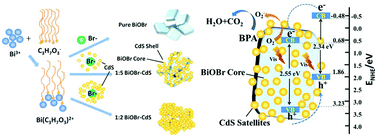In situ crystallization for fabrication of a core–satellite structured BiOBr–CdS heterostructure with excellent visible-light-responsive photoreactivity†
Abstract
We demonstrate the fabrication of a core–satellite structured BiOBr–CdS photocatalyst with highly efficient photocatalytic reactivity via a facile in situ crystallization approach at room temperature. The transmission electron microscopy (TEM) and high-resolution transmission electron microscopy (HR-TEM) results reveal that the BiOBr flakes are surrounded by CdS particles. The coverage of the satellites on the surface of the BiOBr nanosheets could be controlled by changing the content of the CdS, which contributes to the enhanced level of photocatalytic performance. The UV–vis diffuse reflection spectra demonstrate that the visible light absorption of the BiOBr–CdS photocatalyst is also enhanced by the CdS loaded. The excellent structural and spectral properties endow the BiOBr–CdS heterojunctions with improved photocatalytic performance pertaining to bisphenol A (BPA) degradation and photocurrent generation. Under visible light irradiation, the optimum photocatalytic activity of BiOBr–CdS at a molar ratio of 1 : 5 (CdS/BiOBr) is almost 2.8 times and 24.6 times as high as that of pure BiOBr and CdS. The remarkably enhanced photoreactivity should be attributed to the match in the energy levels and close core–satellite structural coupling between the CdS and BiOBr, which greatly facilitates the separation and transfer of photoinduced electron–hole pairs, as confirmed by photoluminescence (PL) and electrochemical impedance spectra (EIS). The present work sheds new light on the construction of highly efficient core–satellite heterojunctional photocatalysts for practical applications.


 Please wait while we load your content...
Please wait while we load your content...